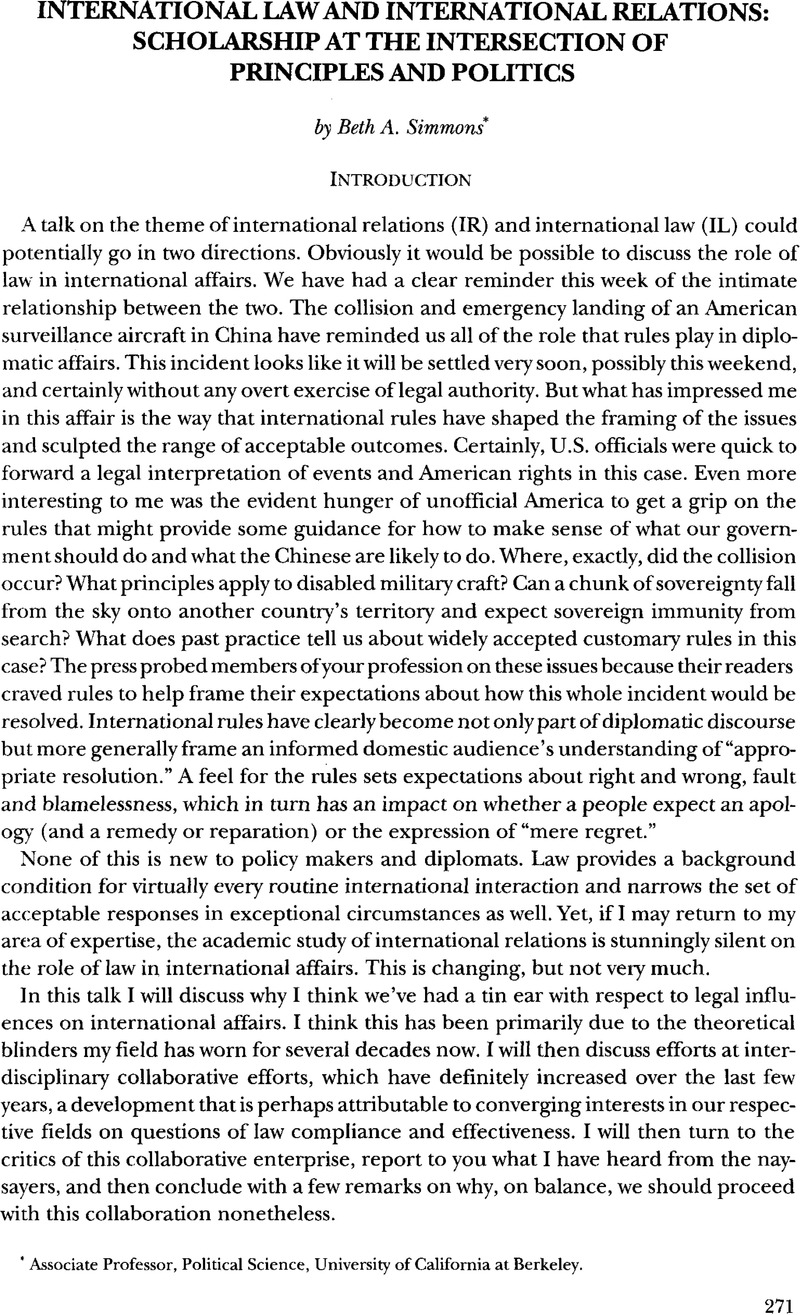Article contents
International Law and International Relations: Scholarship at the Intersection of Principles and Politics
Published online by Cambridge University Press: 28 February 2017
Abstract

- Type
- Meeting Report
- Information
- Copyright
- Copyright © American Society of International Law 2001
References
1 Kratochwil, Friedrich V., How Do Norms Matter, in The Role of Law in International Politics: Essays in International Relationsand International Law 37 (Byers, Michael ed., 2000)Google Scholar.
2 See Hoffmann, Stanley, International Law and the Control of Force, in The Relevance of Internationaij Jaw 47 (Deutsch, Karl & Hoffman, Stanley eds., 1971)Google Scholar.
3 Eyal Benvenisti, Domestic Politics and International Resources: What Role for International Law? in The Role of Law in International Politics, supra note 1, at 107.
4 Abbott, Kenneth W., International Relations Theory, International Law, and the Regime Governing Atrocities in Internal Conflicts, 93 AJIL 361 (1999)CrossRefGoogle Scholar; Burley, Anne-Marie Slaughter, International Law and International Relations Theory: A Dual Agenda, 87 AJIL 205 (1993)CrossRefGoogle Scholar.
5 Stephen J. Toope, Emerging Patterns of Governance and International Law, in The Role of Law in International Politics, supra notel, at 92.
6 See generally Engaging Countries: Strengthening Compliance with International Environmental Accords (Edith Brown Weiss & Harold K. Jacobson eds., 1998) [hereinafter Engaging Countries].
7 Kal Raustiala & Anne-Marie Slaughter, Considering Compliance, in Handbook of International Relations (forthcoming).
8 Abott, Kenneth W. & Snidai, Duncan, Hard and Soft Law in International Governance, 54 Int’l Org. 421-56CrossRefGoogle Scholar; see also Why States Let Through Formal Organizations, 42 J. Conflict Res. 3–32 (1988)Google Scholar.
9 Engaging Countries, supra note 6. See generally Institutions For the Earth: Sources of International Environmental Protection (Peter M. Haas, Robert O. Keohane, & Marc A. Levy eds., 1993).
10 See, e.g., Keck, Margaret & Sikkink, Kathryn, Activists Beyond Borders: Advocacy Networks in International Politics (1998)Google Scholar; Burgerman, Susan D., Mobilizing Principles: The Role of Transnational Activists in Promoting Human Rights Principles, 20 Hum. Rts. Q. 905 (1998)CrossRefGoogle Scholar.
11 Simmons, Beth A., International Law and State Behavior: Commitment and Compliance in International Monetary Affairs, 94 Am. Pol. Sci. Rev. 819 (2000)CrossRefGoogle Scholar.
12 See, e.g., Mearsheimer, John J., The Fahe Promise of International Institutions, 19 Int’l Sec. Rev. 5 (1995)Google Scholar.
13 Kratochwil, Friedrich & Ruggie, John Gerard, International Organization: A State of the Art on an Art of the State, 40 Int’l Org. 753, 768 (1986)CrossRefGoogle Scholar.
14 Kingsbury, Benedict, The Concept of Compliance as a Function of Competing Conceptions of International Law, 19 Mlch. J. Int’l L. 345, 363 (1998)Google Scholar; see also Nollkaemper, Andre, On the Effectiveness of International Rules, 27 Acta Politica 49, 63 (1992)Google Scholar.
15 Slaughter, Anne-Marie, International Law and International Relations Theory: A New Generation of Interdisciplinary Scholarship, 92 AJIL 367, 367 (1998)CrossRefGoogle Scholar.
16 Oran Young, Compliance and Public Authority: A Theory with International Applications 4-5 (1979) (“Compliance can be said to occur when the actual behavior of a given subject conforms to prescribed behavior, and non-compliance or violation occurs when actual behavior departs significantly from prescribed behavior.”) ; see also Engaging Countries, supra note 6 ; Roger Fisher, Improving Compliance (1981); Mitchell, Ronald, Regime design Matters: Intentional Oil Pollution and Treaty Compliance, 48 Int’l. Org. 425 (1994)CrossRefGoogle Scholar. The Implementation and Effectiveness of International Environmental Commitments (Victor, David, Solinikoff, Eugene B., & Raustiala, Kal eds., 1998)Google Scholar.
17 For a description of this approach, See Arend, Anthony Clark, International Rules: Approaches from International Law and International Relations, 300-01 (Beck, Robert, Arend, Anthony Clark, & Lugt, Robert D. Vander eds., 1996)Google Scholar; Tillema, Herbert K. & Van Wingen, John, Law and Power in Military Intervention, 26 Int’l Stud. Q. 220 (1982)CrossRefGoogle Scholar.
18 Martti Koskenniemi, Carl Schmitt, Hans Morgenthau, and the Image of Law in International Relations, in The Role of Law in International Politics, supra note 1, at 29.
19 Id. at 33.
20 Simmons, supra note 11 (arguing that this is exactly how we would expect legal rules to work since they are valued precisely because they create a yardstick for judging reputation).
21 Goldstein, Judith & Martin, Lisa, Legalization, Trade, Liberalization and Domestic Politics: A Cautionary Tale, 54 Int’l Org. 603 (2000)CrossRefGoogle Scholar.
22 Busch, Marc L., Democracy, Consultation, and the Paneling of Disputes Under GATT, 44 J. Conflict Res. 425 (2000)CrossRefGoogle Scholar.
23 The data in this table was found at the political science department Web sites of the following schools: Harvard University at <http://www.harvard.edu>, UC Berkeley at <http://www.berkeley.edu>, University of Michigan at <http://www.umich.edu>, Stanford University at <http://www.yale.edu>, Princeton Universtiy at <http:/www.princeton.edu>, University of Chicago at <http://www.uchicago.edu>, Duke University at <http://www.duke.edu>, MIT at <http://www.mit.edu>, and UCLA at <http://www.ucla.edu>, (all visited Mar. 25, 2001).
24 The data in this table was found in the tables of contents of: World Politics, International Organization, and International Studies Quarterly, 1991-2000.
- 1
- Cited by


